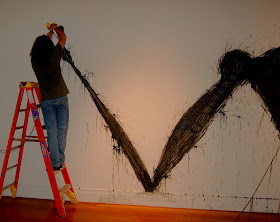
Photo by Richard McCabe.
On Wednesday, January 13, 2010, José Bedia entered the Ogden Museum to create a sight-specific installation for his exhibition opening the following day. It was his fifty-first birthday. Prior to his arrival, we asked what materials he would need for the installation. He requested two things: a bucket of black paint and a bucket of water. In less than three hours, Bedia created a work of striking significance in the context of New Orleans' hosting of ¡Sí Cuba!, a collaborative venture between museums, universities, galleries, and other arts organizations across New Orleans celebrating Cuban art, music and culture.

Photo by Sue Strachan

Photo by Sue Strachan.
The installation includes a dark figure painted directly onto the gallery wall, representing Castro's Cuba. On the floor, in the center or base of the work, is a Palo medicine bundle, representing both Cuba's cultural and spiritual ties to Angola and Bedia's ritual creation of the altar/installation. The floor becomes the ocean turning the baseboards into the horizon. A dog figure, often used to symbolize native cultures, sails away attached to the dark figure with chains. The boat contains cigars and trails an Iberian trane in its wake. This can be seen as the exodus of traditional Cuban culture from the island. Kevin Power, in his definitive essay José Bedia: Field Work in the Human Soul, says of the boat figure: "It speaks both of the way in which the Cuban immigrant drags his traditions along behind him and of the impossibility of ever escaping his past."

Photo by Sue Strachan.
José Bedia's exhibition is the result of a collaboration between the Ogden Museum of Southern Art and Heriard-Cimino Gallery, New Orleans. The gallery is currently exhibiting Fragment of Journeys, new work by José Bedia. The Ogden exhibition and installation will run through April 11, 2010.



